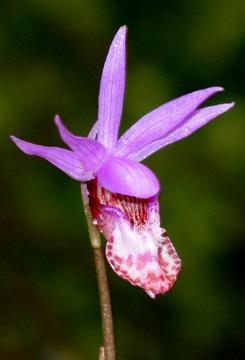As
one of my occasional series of John Muir birthday messages, celebrating
anniversaries of Muir's birth on April 21, 1838, I again send
the following description of one of the most
important encounters in Muir's life. In these
troubled and sad times, it is worth reflecting as Muir did, "It seems
wonderful that so frail and lowly a plant has such power over human
hearts. This Calypso meeting happened some forty-five years ago, and it
was more memorable and impressive than any of my meetings with human
beings excepting, perhaps, Emerson and one or two others..."
May we all be strengthened by more of our own similar
encounters with living things!
Richard Cellarius
Prescott, AZ
April 21, 2006
In 1864, John Muir was wandering through the swamps of Canada, looking for flowers and trees ("botanising") and working at various odd jobs. During this time, Muir long sought a rare orchid, the Calypso borealis. The story of his discovery of Calypso was his first published writing, having been sent on to a newspaper by his former College professor, J.D. Butler, to whom he had written of the discovery in a letter. Years later, Muir expanded on the story,* but the following may be the close to the original text:

 I set off
on the first of my long lonely
excursions, botanising in glorious freedom around the Great Lakes and
wandering through innumerable tamarac and arbor-vitae swamps, and
forests of maple, basswood, ash, elm, balsam, fir, pine, spruce,
hemlock, rejoicing in their bound wealth and strength and beauty,
climbing the trees, revelling in their flowers and fruit like bees in
beds of goldenrods, glorying in the fresh cool beauty and charm, of the
bog and meadow heathworts, grasses, carices, ferns, mosses, liverworts
displayed in boundless profusion.
I set off
on the first of my long lonely
excursions, botanising in glorious freedom around the Great Lakes and
wandering through innumerable tamarac and arbor-vitae swamps, and
forests of maple, basswood, ash, elm, balsam, fir, pine, spruce,
hemlock, rejoicing in their bound wealth and strength and beauty,
climbing the trees, revelling in their flowers and fruit like bees in
beds of goldenrods, glorying in the fresh cool beauty and charm, of the
bog and meadow heathworts, grasses, carices, ferns, mosses, liverworts
displayed in boundless profusion.The rarest and most beautiful of the flowering plants I discovered on this first grand excursion was Calypso borealis (the Hider of the North). I had been fording streams more and more difficult to cross and wading bogs and swamps that seemed more and more extensive and more difficult to force one’s way through. Entering one of these great tamarac and arbor-vitae swamps one morning, holding a general though very crooked course by compass, struggling through tangled drooping branches and over and under broad heaps of fallen trees, I began to fear that I would not be able to reach dry ground before dark, and therefore would have to pass the night in the swamp...
But when the sun was getting low and everything seemed most bewildering and discouraging, I found beautiful Calypso on the mossy bank of a stream, growing not in the ground but on a bed of yellow mosses in which its small white bulb had found a soft nest and from which its one leaf and one newer sprung. The flower was white and made the impression of the utmost simple purity like a snowflower. No other bloom was near it, for the bog a short distance below the surface was still frozen, and the water was ice cold. It seemed the most spiritual of all the flower people I had ever met. I sat down beside it and fairly cried for joy.
How long I sat beside Calypso I don’t know. Hunger and weariness vanished, and only after the sun was low in the west I plashed on through the swamp, strong and exhilarated as if never more to feel any mortal care.**
*[Source: http://www.sierraclub.org/john_Muir_exhibit/writings/calypso_borealis_by_muir.html, accessed 4/16/2006]
**[Source: http://www.greenspirit.org.uk/resources/Epiphanies.htm, accessed 4/16/2006]
[See also: "Being John Muir," http://www.uuca-md.org/sermons/jmuir.html, accessed 4/16/2006]
[Flower Image source: http://pics.davesgarden.com/pics/pdb_momshu_2003-05-27_1054011038980.jpg, accessed 4/16/2006]
[Muir image source: http://www.sierraclub.org/john_muir_exhibit/pictures/graphics/john_muir_in_1872_san_francisco_photo.jpg, accessed 4/16/2006]